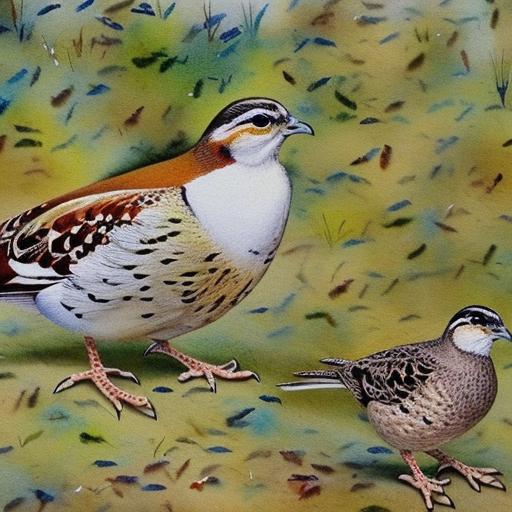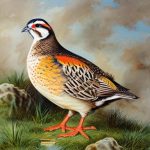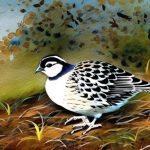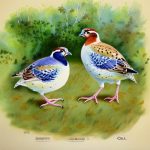Quail color genetics can be a complex and fascinating subject for breeders. Understanding the basics of genetics is crucial for successful breeding and achieving desired color varieties in quail. In quail, color genetics are determined by the interaction of various genes that control the production of pigments in the feathers. These genes can be inherited from the quail’s parents and passed down through generations, resulting in a wide range of color variations.
One of the key factors in understanding quail color genetics is the concept of dominant and recessive genes. Dominant genes are those that are expressed in the bird’s phenotype, or physical appearance, while recessive genes are only expressed when they are paired with another recessive gene. This means that a quail with a dominant gene for a certain color will display that color, while a quail with two recessive genes for a different color will also display that color. Understanding how these genes interact and are passed down through breeding is essential for predicting the outcomes of different mating pairs.
Additionally, quail color genetics can be influenced by other factors such as sex-linked genes, which are located on the sex chromosomes and can result in different color patterns in male and female quail. In order to successfully breed for specific color varieties, breeders must have a solid understanding of these genetic principles and how they apply to quail breeding.
Key Takeaways
- Quail color genetics are complex and involve multiple genes that determine the color variations in quail.
- Breeding quail for specific color varieties requires an understanding of basic genetics and inheritance patterns.
- Common quail color varieties include wild-type, tuxedo, silver, and cinnamon, each with distinct genetic traits.
- Using a quail color breeding chart can help breeders track and predict the outcomes of different color pairings.
- Maintaining genetic diversity is crucial for the long-term health and viability of quail color breeding programs.
The Basics of Quail Color Breeding
Breeding quail for specific color varieties requires careful planning and selection of breeding pairs. The first step in quail color breeding is to identify the desired color variety and understand the genetic makeup of that color. This involves researching the specific genes and alleles that control the expression of the desired color, as well as understanding how these genes interact with other genes in the quail’s genome.
Once the genetic basis of the desired color variety is understood, breeders can then select breeding pairs that carry the necessary genes to produce that color. This may involve crossing quail with known color genetics to produce offspring with the desired traits, or selectively breeding quail with specific color patterns to reinforce those traits in future generations.
In addition to selecting breeding pairs based on their genetic makeup, breeders must also consider other factors such as health, temperament, and overall conformation when choosing birds for breeding. By carefully selecting breeding pairs that not only carry the desired color genetics but also exhibit other desirable traits, breeders can work towards producing high-quality quail with consistent and attractive color varieties.
Common Quail Color Varieties
Quail come in a wide range of color varieties, each with its own unique genetic basis and inheritance patterns. Some of the most common quail color varieties include:
– Wild-type: The wild-type color variety is the natural coloration of quail found in the wild. It typically consists of a mottled brown and buff pattern that provides camouflage in their natural habitat. The genetics of wild-type coloration are complex, involving multiple genes that control the distribution of pigments in the feathers.
– Tuxedo: Tuxedo quail are characterized by a striking black and white pattern, with black feathers on the head and back and white feathers on the chest and belly. The genetics of tuxedo coloration involve specific alleles that control the distribution of pigments in the feathers, resulting in the distinctive black and white pattern.
– Rosetta: Rosetta quail have a unique combination of reddish-brown and white feathers, giving them a distinctive and attractive appearance. The genetics of rosetta coloration involve specific alleles that control the production of red pigments in the feathers, as well as modifiers that influence the distribution of those pigments.
– Blue: Blue quail have a dilute bluish-gray coloration that is caused by specific alleles that affect the production of melanin pigments in the feathers. The genetics of blue coloration involve interactions between multiple genes that control the expression of melanin pigments, resulting in the unique blue color variety.
These are just a few examples of the many color varieties found in quail, each with its own genetic basis and inheritance patterns. By understanding the genetics of these color varieties, breeders can work towards producing quail with specific and desirable color patterns.
Using a Quail Color Breeding Chart
A quail color breeding chart is a valuable tool for breeders to track the inheritance patterns of different color varieties and plan their breeding programs accordingly. These charts typically display the genetic makeup of different color varieties, including the specific alleles and genes that control their expression, as well as the inheritance patterns when different color varieties are crossed.
Using a quail color breeding chart, breeders can predict the outcomes of different mating pairs and plan their breeding programs to achieve specific color varieties. By understanding which genes are responsible for producing certain colors and how they are inherited from parent to offspring, breeders can make informed decisions about which birds to pair together to produce offspring with desired traits.
In addition to tracking specific color varieties, quail color breeding charts can also help breeders maintain genetic diversity within their breeding programs. By carefully selecting breeding pairs based on their genetic makeup and considering factors such as relatedness and inbreeding, breeders can work towards producing healthy and genetically diverse quail with a wide range of desirable color varieties.
Tips for Successful Quail Color Breeding
Breeding quail for specific color varieties requires careful planning and attention to detail. Here are some tips for successful quail color breeding:
1. Research the genetics of desired color varieties: Before starting a breeding program for specific color varieties, it’s important to thoroughly research the genetic basis of those colors. This involves understanding which genes and alleles control the expression of specific colors, as well as how those genes interact with each other in inheritance patterns.
2. Select breeding pairs based on genetic makeup: When choosing birds for breeding, it’s essential to select pairs that carry the necessary genes to produce the desired color variety. This may involve crossing birds with known color genetics or selectively breeding birds with specific color patterns to reinforce those traits in future generations.
3. Consider other traits besides color: While producing specific color varieties is a primary goal of quail breeding, it’s also important to consider other traits such as health, temperament, and overall conformation when selecting birds for breeding. By choosing birds that exhibit desirable traits beyond just color, breeders can work towards producing high-quality quail with consistent and attractive characteristics.
4. Use a quail color breeding chart: A quail color breeding chart can be a valuable tool for tracking inheritance patterns and planning breeding programs. By using a breeding chart to predict the outcomes of different mating pairs, breeders can make informed decisions about which birds to pair together to produce offspring with desired traits.
5. Maintain genetic diversity: Inbreeding can lead to health problems and reduced genetic diversity within a breeding program. To avoid these issues, breeders should carefully consider factors such as relatedness and inbreeding when selecting breeding pairs, and work towards maintaining healthy and genetically diverse quail populations.
By following these tips and paying close attention to genetic principles, breeders can work towards producing high-quality quail with specific and desirable color varieties.
Maintaining Genetic Diversity in Quail Color Breeding

Maintaining genetic diversity is crucial for the long-term health and viability of quail populations. Inbreeding can lead to an increased risk of genetic disorders and reduced overall fitness within a population. To maintain genetic diversity in quail color breeding programs, breeders should carefully consider factors such as relatedness, inbreeding, and population size.
One way to maintain genetic diversity is by avoiding close relatives when selecting breeding pairs. By choosing birds that are less closely related, breeders can reduce the risk of inheriting harmful recessive traits that may be present in closely related individuals. Additionally, maintaining a larger population size can help prevent inbreeding by providing more potential breeding pairs and reducing the likelihood of mating between closely related individuals.
Another strategy for maintaining genetic diversity is through outcrossing with unrelated individuals from outside sources. Introducing new genetic material from unrelated populations can help refresh the gene pool and reduce the risk of inbreeding depression. However, it’s important to carefully quarantine and test new birds for diseases before introducing them to an existing population to prevent the spread of illness.
Overall, maintaining genetic diversity in quail color breeding programs requires careful planning and consideration of factors such as relatedness, population size, and outcrossing with unrelated individuals. By taking steps to avoid inbreeding and refresh the gene pool with new genetic material, breeders can work towards producing healthy and genetically diverse quail populations with a wide range of desirable color varieties.
Resources for Quail Color Breeding enthusiasts
For enthusiasts interested in learning more about quail color breeding, there are many resources available to help expand their knowledge and skills in this area. Books on avian genetics and poultry breeding often contain valuable information on understanding the genetics of different color varieties in quail, as well as practical tips for successful breeding programs.
Additionally, online forums and social media groups dedicated to quail breeding can provide a platform for enthusiasts to connect with other breeders, share experiences, and seek advice on specific breeding challenges. These communities often provide a wealth of knowledge and support for those interested in delving deeper into quail color genetics and breeding techniques.
Attending poultry shows and exhibitions can also be a valuable way to learn from experienced breeders and see firsthand examples of different quail color varieties. These events often feature educational seminars and workshops on avian genetics and breeding practices, providing enthusiasts with an opportunity to expand their knowledge and network with other like-minded individuals.
Finally, reaching out to local or national poultry associations can provide access to additional resources such as publications, workshops, and mentorship programs for those interested in furthering their skills in quail color breeding. By taking advantage of these resources, enthusiasts can continue to grow their expertise and passion for producing high-quality quail with specific and desirable color varieties.
If you’re interested in quail color breeding, you might also want to check out this article on large chicken coop ideas. Creating the right environment for your quails is essential for successful breeding, and understanding how to design and maintain a suitable coop is crucial. This article provides valuable insights into creating a spacious and comfortable living space for your poultry, which can directly impact their health and breeding success.
FAQs
What is a quail color breeding chart?
A quail color breeding chart is a visual representation of the different color variations that can be bred in quail. It helps breeders understand the genetics behind quail coloration and plan their breeding programs to achieve specific color outcomes.
How is a quail color breeding chart used?
Quail breeders use the color breeding chart to predict the potential color outcomes of breeding different quail pairs. By understanding the genetic inheritance of different color traits, breeders can select specific birds to breed in order to produce desired color variations in their quail flocks.
What information does a quail color breeding chart provide?
A quail color breeding chart provides information on the genetic inheritance of different color traits in quail, including dominant and recessive color genes, as well as the potential outcomes of breeding different color variations together.
Where can I find a quail color breeding chart?
Quail color breeding charts can be found in quail breeding guides, books on avian genetics, and on various websites and forums dedicated to quail breeding and genetics. Breeders may also create their own customized breeding charts based on their specific quail color breeding goals.
Are quail color breeding charts accurate?
Quail color breeding charts are based on the principles of avian genetics and can provide a general understanding of color inheritance in quail. However, there may be variations and exceptions in actual breeding outcomes due to the complexity of genetic interactions. It is important for breeders to use the breeding chart as a guide and be prepared for some variability in color outcomes.
Meet Walter, the feathered-friend fanatic of Florida! Nestled in the sunshine state, Walter struts through life with his feathered companions, clucking his way to happiness. With a coop that’s fancier than a five-star hotel, he’s the Don Juan of the chicken world. When he’s not teaching his hens to do the cha-cha, you’ll find him in a heated debate with his prized rooster, Sir Clucks-a-Lot. Walter’s poultry passion is no yolk; he’s the sunny-side-up guy you never knew you needed in your flock of friends!







